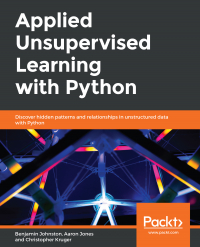Applied Unsupervised Learning with Python
Discover hidden patterns and relationships in unstructured data with Python


About the Book
Book description
Design clever algorithms that can uncover interesting structures and hidden relationships in unstructured, unlabeled data
Key Features
- Learn how to select the most suitable Python library to solve your problem
- Compare k-Nearest Neighbor (k-NN) and non-parametric methods and decide when to use them
- Delve into the applications of neural networks using real-world datasets
Book Description
Unsupervised learning is a useful and practical solution in situations where labeled data is not available.
Applied Unsupervised Learning with Python guides you on the best practices for using unsupervised learning techniques in tandem with Python libraries and extracting meaningful information from unstructured data. The course begins by explaining how basic clustering works to find similar data points in a set. Once you are well versed with the k-means algorithm and how it operates, you’ll learn what dimensionality reduction is and where to apply it. As you progress, you’ll learn various neural network techniques and how they can improve your model. While studying the applications of unsupervised learning, you will also understand how to mine topics that are trending on Twitter and Facebook and build a news recommendation engine for users. You will complete the course by challenging yourself through various interesting activities such as performing a Market Basket Analysis and identifying relationships between different merchandises.
By the end of this course, you will have the skills you need to confidently build your own models using Python.
What you will learn
- Understand the basics and importance of clustering
- Build k-means, hierarchical, and DBSCAN clustering algorithms from scratch with built-in packages
- Explore dimensionality reduction and its applications
- Use scikit-learn (sklearn) to implement and analyse principal component analysis (PCA)on the Iris dataset
- Employ Keras to build autoencoder models for the CIFAR-10 dataset
- Apply the Apriori algorithm with machine learning extensions (Mlxtend) to study transaction data
Who this book is for
This course is designed for developers, data scientists, and machine learning enthusiasts who are interested in unsupervised learning. Some familiarity with Python programming along with basic knowledge of mathematical concepts including exponents, square roots, means, and medians will be beneficial.

eBook Preview
Author Details
Packt are an established, trusted, and innovative global technical learning publisher, founded in Birmingham, UK with over eighteen years experience delivering rich premium content from ground-breaking authors and lecturers on a wide range of emerging and established technologies for professional development.
Packt’s purpose is to help technology professionals advance their knowledge and support the growth of new technologies by publishing vital user focused knowledge-based content faster than any other tech publisher, with a growing library of over 9,000 titles, in book, e-book, audio and video learning formats, our multimedia content is valued as a vital learning tool and offers exceptional support for the development of technology knowledge.
We publish on topics that are at the very cutting edge of technology, helping IT professionals learn about the newest tools and frameworks in a way that suits them.
Our students work
with the Best


































Related eBooks
Annual Membership
Become a valued member of Tutorials Point and enjoy unlimited access to our vast library of top-rated Video Courses
Subscribe now
Online Certifications
Master prominent technologies at full length and become a valued certified professional.
Explore Now







